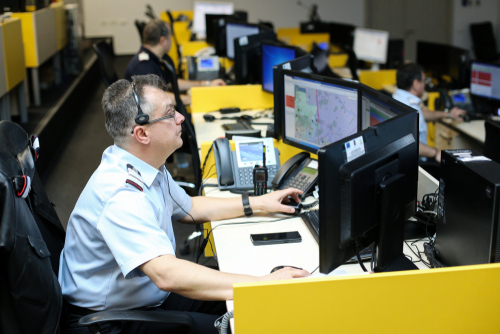Kari’s Law and the Ray Baum’s Act are two pieces of federal legislation concerning Enhanced 911 (E911) services. These are advanced services for 911, the universal telephone number used in the United States for emergency services. Facilities management professionals should understand these laws to ensure that their facilities are compliant.

These laws were discussed during a fireside chat entitled “Prep, Plan, Protect: An E911 Compliance Roadmap” that recently wrapped-up Facilities Management Compliance Week 2022. The virtual chat featured Matt Schmid, Senior Product Marketing Manager of software provider Everbridge.
Schmid said that the legislation is under the jurisdiction of the Federal Communications Commission (FCC) and affects all communication devices, including Multi-Line Telephone Systems (MLTS) such as those at a college campus or large workplace.
Before these laws were in place, companies or universities could decide that a universal way of communicating to emergency services was not a priority. However, now that a universal law is in place, organizations failing to adhere to it can be called out for not following the law and would be subject to consequences.
“Somebody can point to this and say ‘Hey, you aren’t compliant,’” noted Schmid. “This is now where you can plainly see that the corporate risk portfolio just grew significantly.”
Kari’s Law
The FCC law known as Kari’s Law went into effect Feb. 16, 2020. It is named after Kari Hunt, who was murdered by her estranged husband in a hotel bathroom in 2013. According to an FCC Podcast, her nine-year-old daughter attempted to dial 911 four times using a hotel telephone while her mother was being stabbed. The call did not go through, as the hotel phone system requires dialing “9” before placing an outside call.
Although her daughter attempted to get help from hotel staff, they did not understand her since they did not know English and failed to contact the hotel manager.
As a result, Schmid said that the hotel had to pay a $41 million legal claim to the family.
According to an MLTS FAQS document from the FCC, the law requires that:
- All MLTS allow 911 calls to be dialed directly;
- Appropriate staff receive notification that a 911 call has been placed;
- Appropriate staff should be employees at a front desk, security office, or administrators; and
- Notification should have a callback number and location so that appropriate staff can help or direct emergency personnel to the location.
To implement Kari’s Law, Schmid suggests that facility professionals:
- Connect with technology partners to ensure they understand the phone system; and
- Determine who should be notified if a 911 call is placed.
Who is impacted? According to 911.gov, the following businesses with MLTS must comply:
- Companies with offices in multiple locations;
- Campuses, including K-12, universities, and colleges;
- Hospitals;
- Hotels;
- Retail facilities; and
- Financial institutions.
Ray Baum’s Act
The Ray Baum’s Act, which went fully into effect Jan. 6, 2022, requires employers to ensure every building has its own address, also called a “dispatchable location,” Schmid said. The act is named after the late Raymond Sims Baum, who worked with the FCC on communications issues.
To meet the requirements of this act, professionals should:
- Map and list every dispatchable location;
- List all electronic devices owned by the company, including static devices on desks and conference rooms, as well as nomadic devices like laptops, tablets, and smartphones; and
- Identify the infrastructure that will be used to locate the device.
Dispatchable Location
A dispatchable location is defined as being a street address with a floor, office, room, or cubical number or a zone (such as: northwest corner of a receiving area).
“It’s important to note that the FCC went out of its way not to quantify dispatchable location.,” Schmid said, adding, “For example, they didn’t say you need a dispatchable location for every 10,000 square feet.”
The importance of a dispatchable location is the ability for a first responder to quickly find someone who needs emergency services. Care should be taken with areas with obstructed views versus areas with open lines of sight.
Schmid said that the importance of the identification of electronic devices has grown since “people will be working remotely indefinitely. You need to make sure that your employees who are using corporate assets and working remotely are protected.”
In this instance, a dispatchable location can be defined either by an address provided by the user or an address provided by available technology on the device.
Penalties
Everbridge reports that those failing to comply with these rules could face a “fine of up to $10,000 plus $500/day for the period of non-compliance.”
To learn more about E911, check out this webinar for free on-demand by clicking here.
